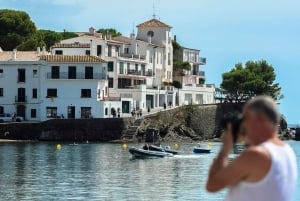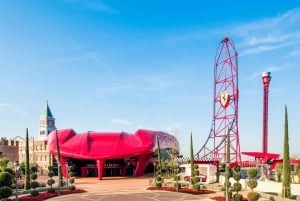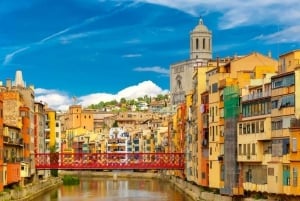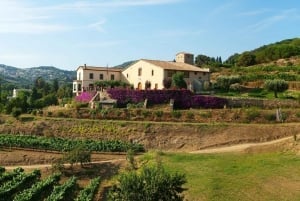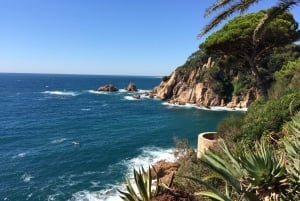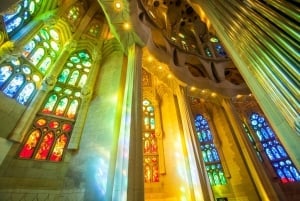Barcelona Antoni Gaudí - Modernisme
Early Years:
For all the things Barcelona is famous for, Antoni Guillem Gaudi stands out as one of the great city’s most influential characters with his classic works acting as a major pulling factor with visitors to the city.
Born on June 25th 1852 in the Catalunyan province of Tarragona, Gaudi would later become a regarded, legend of world architecture with his vast collection of unique work. From a young age, Gaudi suffered from health problems in the form of rheumatism which consequently made his childhood slightly different to that of other children. He suffered pain when walking and in turn was forced to become absent from many school lessons. Yet this did not impair his creativity. Whilst missing out on typical educational provisions, Gaudi found time to observe and interpret the natural world around him, paying attention to forms and designs which would later become embodied in his architectural styling.
Aged 16, Gaudi moved across Catalunya to take up the study at the ‘Upper Technical School of Architecture’ in Barcelona. Interestingly, Gaudi deduced that different architectural styles did not entirely hinge upon aesthetic ideas but moreover, upon the social and political atmosphere which surrounded them. Owing to this, he also enrolled in Philosophy and History classes to further round his overall understandings of the environment in which he sought to create his ideas.
Similar to many creative personalities, Gaudi’s actual grades in education were not exactly outstanding. Despite not being the most gifted ‘student’ in terms of ‘academic study’, he demonstrated a sublime level of natural creativity whilst gaining a sound knowledge of elementary architecture.
Whist studying, Gaudi took up employment with some builders in Barcelona, as a way of supporting himself. Soon enough however, he was drafting his first blueprints out, for parts of the Monastery at Montserrat as well as the Ciutadella. Stimulus for many of Gaudi’s early designs came largely from his love of medieval books and their examples of Gothic art, which was, at the time, experiencing a renaissance. Gaudi soon developed a style of his own which drew upon natural shapes and ornate patterns.
Gaudi: The Working Man.
Moving into the 1900’s, Barcelona itself had begun to flourish with thanks to the local boom in the maritime and textile industries. Many wealthy people were now residing in Barcelona and in turn, a niche was created for artists, performers, and intellectuals whom appealed to bourgeois culture. For a young architect with a flair for originality, this was an ideal atmosphere with which to practice his trade. Gaudi achieved his primary contracts through collaborations with other architects including Martorell. The importance of this relationship would later prove imperative to Gaudi’s creation of his most recognised work; La Sagrada Familia.
Throughout his career, Gaudi would leave a footprint upon Barcelona which is yet unsurpassed by any other creator, architectural or otherwise. In the coming paragraphs we will explore some of his most significant examples around the city.
Gaudi’s first major work of significance in Barcelona is ‘Casa Vicens’. Located on ‘Carrer de les Carolines’ in the Gràcia district of the city, Casa Vicens is now a listed UNESCO World Heritage Site and still serves as its original function as a residential property. Gaudi constructed Casa Vicens in 1883 for a local stock broker named Manuel Montaner, who had commissioned the architect to build him a home on the land he had inherited from his mother. Although not as grand or well known as the buildings which would later grace Barcelona’s skyline, Casa Vicens provided a sound example of things to come with its large, landscaped gardens and monumental fountain (later destroyed due to sale of that piece of land).
Constructed between 1886 and 1890, the Palau Güell was constructed by Gaudi. He had received the commission from Eusebi Güell. Initially, Eusebi Güell had the desire to use the building in order to improve the surrounding area’s ‘notorious’ reputation by providing an example of high-class. Palau Güell is located on ‘Carrer Nou de la Rambla’, just off of the famous ‘Las Ramblas’ and historically, this district of El Raval in Barcelona was associated with the vagrants of the city as well as prostitutes. To this day, there is an on-going push to rid El Raval of these same, unfortunate associations with a problematic society. It must be argued that the area has now vastly improved and indeed, hosts many of the cities great local business, retail premises. Güell did not set a limit on the project's budget and in turn, Gaudi was able to use the finest materials to carry out his plans.
Since the year 1945, Palau Güell Palace has been owned by Barcelona Provincial Council, the local government institution which oversees health and welfare for the province of Barcelona. Palau Güell is another listed UNESCO World Heritage Site and was opened to the public for viewing in 1996. Please note that at the time of writing this very text, the Palau Güell is closed for vital restoration work and potential visitors may only view it from the street outside.
As well as commissioning Gaudi to build the Palau Güell, Eusebi Güell also took advantage of Gaudi’s seemingly impeccable knack of incorporating natural designs into his work by also giving him the contract to design parts of the famous Parc Güell. Potentially serving as one of Gaudi’s most unique works in Barcelona, Parc Güell is now declared as a UNESCO World Heritage site. Without question, this is one of Gaudi’s most beautiful works. Intended to be known as a ‘Garden City’ by Eusebi Güell, the park is a totally environmentally-aware development. Changes to the natural terrain were not made and this results in a bizarre, and often steep, winding arrangement of design and nature. Recycled pieces of material from local ceramics factories were used to create many of the mosaic designs and absolutely no flora, nor fauna was displaced despite the complex blueprints.
At this time in Gaudi’s architectural career, other than his on-going project at Parc Güell, the true genius was yet to fully shine. This moment indeed came with the completion of Casa Batlló in 1906. The famous building which adorns the infamous Passeig de Grácia in L’Eixample, Barcelona, which has become one of the city’s most visited buildings. The original building was owned by Josep Batlló, and it served as a house. Gaudi undertook a complete renovation of the property and added the famous balconies and fantastic, vast, street facing windows which allow for better distribution of natural light, a feature which became synonymous with Gaudi’s designs. The striking modernist façade conceals a whole world of artistic and architectural surprises.
La Pedrera was constructed by Gaudi for a wealthy aristocrat named Pere Milà. The aristocrat wanted a grand home for his family which would also encompass a series of ‘rentable’ private dwellings for other Barcelona residents. Milà was enthusiastic about Gaudi’s work after seeing the way he had wonderfully renovated Casa Batlló. Gaudi did not disappoint with La Pedrera, he masterfully planned and constructed a superb house with undulating, living forms. La Pedrera still stands along with Casa Batlló amongst the most prominent and interesting structures on Passeig de Grácia. In the present day, La Pedrera is owned by the bank 'Caixa Catalunya', who have in turn, thus far invested €50million in order to restore the building, back to its original glory.
La Pedrera was the last great privately contracted work Gaudi executed, before dedicating what would be, the rest of his life to La Sagrada Familia.
Towards the end of the 1800’s it had been decided that a new Catholic place of worship should be constructed in Barcelona. This project, headed by Francisco de Paula del Villar, who was in fact Gaudi’s one-time professor, was to see a grand Church built in the L’Eixample area of the city. This Church was of course La Sagrada Familia. Following disagreements over the design plans between the Church council, Villar decided to step down and hand the leadership over to Martorell. Martorell however, decided against leading the project and instead, suggested Gaudi should take the reins. The rest as they say is history; a history which is indeed, still in the making some 128 years later.
| Famous Antoni Gaudi Works in Barcelona |
| Browsing Gaudi |
| Casa Batllo Distance |
| Gaudi Face |
| La Pedrera |
| La Segunda Familia |
| Placa Reial Gaudi Lamposts |
| La Sagrada Familia |
The death of Barcelona’s Son:
In his later life, Gaudi was socially, non-conformist. He dressed in a manner quite different to that of his earlier years. His clothes did not really reflect the wealth and status of the man. This is rather significant in terms of Gaudi’s death. On June 7th, 1926, the great architect was hit by a tram on a busy junction on Gran Via, a busy road in Barcelona. Upon seeing a ‘poor’, undesirable, vagabond lying injured on the ground, the passing Taxi drivers refused to stop and take such a person to the hospital. Because of the severity of the accident and the neglect of people, Antoni Guillem Gaudi died shortly after aged 74. His body was laid to rest in the place he had spent the last 43 years of his life working; inside the crypt at La Sagrada Familia.
The legend of this great man lives on in Barcelona with millions of people coming to the city to celebrate his achievements, year in, year out. Visiting at least one of Gaudi’s work’s is of course, a ‘must do’ during any trip to Barcelona.



